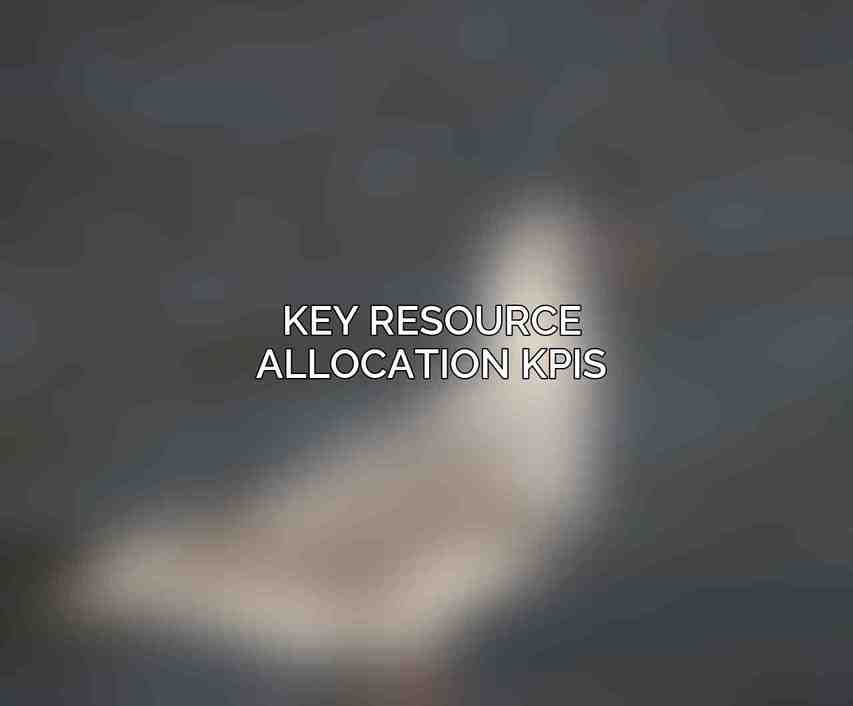Effective resource allocation is crucial for the success of any endeavor. to optimize resource allocation strategies, it is essential to monitor and analyze key metrics that provide insights into resource utilization, efficiency, cost, availability, and demand. By understanding and leveraging these metrics, organizations can make informed decisions to enhance productivity, minimize waste, and achieve optimal outcomes.
Key Resource Allocation Metrics
Resource Utilization Rate
Resource utilization rate is a fundamental metric that measures the percentage of time a resource is actively engaged in productive work. Calculated as Total Active Time divided by Total Available Time, this metric offers insights into how efficiently resources are utilized within a given timeframe. The optimal range for resource utilization typically falls between 70-85%, allowing organizations to identify underutilized resources and improve resource planning and scheduling. Explore further with Top Resource Allocation Strategies for Project Success Check this blog on How to Maximize Project Efficiency with Limited Resources
| Metric | Formula | Optimal Range |
|---|---|---|
| Resource Utilization Rate | Total Active Time / Total Available Time | 70-85% |
Resource Efficiency

Resource efficiency measures the ratio of work output to resource input, providing a gauge of resource productivity. By calculating Work Output divided by Resource Input, organizations can assess how effectively resources are utilized in generating outputs. The optimal range for resource efficiency varies depending on the project and resource type, enabling tailored assessments for different scenarios. Check this blog on Best Resource Allocation Software: 2024 Reviews
| Metric | Formula | Optimal Range |
|---|---|---|
| Resource Efficiency | Work Output / Resource Input | Depends on project and resource type |
Resource Cost
Resource cost is a critical metric that encapsulates the total expenses associated with utilizing a resource. Comprising direct costs and indirect costs, the calculation of Resource Cost allows organizations to control expenses and make informed decisions about resource allocation. Striving to minimize resource costs helps in optimizing resource utilization and maximizing cost-efficiency.
| Metric | Formula | Optimal Range |
|---|---|---|
| Resource Cost | Direct Costs + Indirect Costs | Minimized |
Resource Availability
Resource availability indicates the percentage of time a resource is accessible for allocation. By computing (Total Time
– Unavailable Time) divided by Total Time, organizations can ensure timely resource allocation and prevent project delays. Ideally, aiming for high resource availability, close to 100%, enhances operational efficiency and minimizes disruptions due to resource unavailability.
| Metric | Formula | Optimal Range |
|---|---|---|
| Resource Availability | (Total Time – Unavailable Time) / Total Time | High (ideally 100%) |
Resource Demand
Resource demand reflects the quantity of resources required to fulfill tasks or projects. Calculated as Estimated Workload divided by Resource Capacity, this metric aids in preventing overallocation, resource conflicts, and optimizing resource utilization. Ensuring that resource demand aligns within resource capacity helps maintain operational balance and efficiency.
| Metric | Formula | Optimal Range |
|---|---|---|
| Resource Demand | Estimated Workload / Resource Capacity | Within resource capacity |
Key Resource Allocation KPIs

Resource Allocation Scorecard
The Resource Allocation Scorecard serves as a comprehensive assessment tool for evaluating resource allocation performance. By incorporating metrics such as Resource Utilization Rate, Resource Efficiency, Resource Cost, Resource Availability, and Resource Demand, organizations gain a holistic view of resource utilization and allocation effectiveness. This scorecard facilitates continuous improvement by identifying areas for optimization and enhancement.
Project Completion Index
The Project Completion Index measures the ratio of actual project completion time to planned completion time, expressed as a percentage. Calculated by dividing Actual Completion Time by Planned Completion Time and multiplying by 100, this KPI assists in evaluating project resource allocation efficiency. Achieving a Project Completion Index of 100% or less indicates effective resource utilization and aids in identifying potential bottlenecks that may impede project progress.
Cost Performance Index
The Cost Performance Index evaluates the efficiency of resource allocation by comparing actual project costs to planned project costs. Determined as (Earned Value / Actual Cost) * 100, this KPI enables organizations to control expenses, monitor budget adherence, and optimize resource allocations. Achieving a Cost Performance Index of 100% or less signifies efficient resource utilization and cost-effective project management practices.
Value Delivered per Resource
Value Delivered per Resource quantifies the value generated by a resource relative to its cost. Calculated as Value Delivered divided by Resource Cost, this metric offers insights into the return on investment derived from resource allocations. Maximizing the Value Delivered per Resource helps in making informed decisions regarding resource allocations, leveraging resources effectively, and enhancing overall project outcomes.
Resource Over/Under Allocation Index
The Resource Over/Under Allocation Index measures the extent to which resources are either overallocated or underallocated within a project. By computing (Actual Resource Allocation Explore further with Ultimate Guide to Agile Resource Allocation
– Planned Resource Allocation) divided by Planned Resource Allocation, organizations can identify resource allocation imbalances and initiate corrective actions. Maintaining a Resource Over/Under Allocation Index close to zero indicates optimal resource allocation and balanced resource utilization.
monitoring and analyzing key metrics and KPIs related to resource allocation is essential for organizations seeking to optimize efficiency, enhance productivity, and achieve successful project outcomes. By leveraging these indicators, organizations can make data-driven decisions, allocate resources effectively, and continuously improve their resource management practices.
By consistently evaluating and optimizing these metrics, organizations can stay agile and adaptive in the ever-evolving business world of the 21st century. Effortlessly incorporating advanced technologies and tools like project management software, organizations can streamline their resource allocation processes, leading to improved performance and sustainable growth.
Frequently Asked Questions
What are key metrics for effective resource allocation?
Key metrics for effective resource allocation include return on investment (ROI), resource utilization rate, project completion rate, cost variance, and schedule variance.
Why is it important to measure these metrics?
Measuring these metrics helps in evaluating the efficiency and effectiveness of resource allocation, identifying areas of improvement, making data-driven decisions, and maximizing the return on investment.
How can ROI be calculated for resource allocation?
ROI can be calculated by dividing the net gain from investment (benefits minus costs) by the initial investment, and then multiplying the result by 100 to get a percentage.
What is resource utilization rate and how is it calculated?
Resource utilization rate is the percentage of time that a resource is actively used. It can be calculated by dividing the total number of hours a resource is used by the total number of hours it is available, and then multiplying by 100.
How can cost variance and schedule variance help in resource allocation?
Cost variance and schedule variance help in comparing the planned versus actual costs and timelines of a project respectively, enabling project managers to address any deviations and make necessary adjustments to resources.

